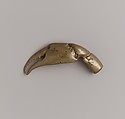Gold Weight: Lobster Claw
Not on view
In most Akan gold-weight designs, attention to realism was so highly prized that often organic materials were cast directly, without the creation of an intermediary wax mold. These two examples use a crab claw and chicken claw as a point of departure. Often insects, pea pods, or peanuts, among others, were placed in a mold and then burned out, leaving space for the molten metal to be poured. These forms often relate directly to important Akan proverbs. For example, the crab claw is associated with a verbal challenge, referring to the tenacious grip of the animal itself. In a commercial exchange, use of this weight would have expressed hostility and frustration. Successful Akan traders were known for their verbal skills and mastery of the oral arts. The use of a varied repertory of symbolic gold weights enhanced these complicated interactions.
Due to rights restrictions, this image cannot be enlarged, viewed at full screen, or downloaded.

